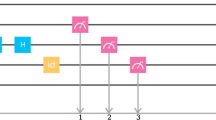Abstract
A quantum state represents neither properties of a physical system nor anyone’s knowledge of its properties. The important question is not what quantum states represent but how they are used—as informational bridges. Knowing about some physical situations (its backing conditions), an agent may assign a quantum state to form expectations about other possible physical situations (its advice conditions). Quantum states are objective: only expectations based on correct state assignments are generally reliable. If a quantum state represents anything, it is the objective probabilistic relations between its backing conditions and its advice conditions. This paper offers an account of quantum states and their function as informational bridges, in quantum teleportation and elsewhere.
Similar content being viewed by others
Notes
For further details, see Healey [6].
For a fuller account see Healey [7].
By adding a classical channel it may be used to teleport entanglement of a Qbit.
Although the authors of a documentary film about him called it The Unknown Known, suggesting that he might have been one.
But doesn’t Carol herself provide such a physical channel? Not if all traces of what she did have been erased from her brain and the rest of her body.
References
Bell, J.S.: Speakable and Unspeakable in Quantum Mechanics. Cambridge University Press, Cambridge (2004). Revised edition
Brun, T., Finkelstein, J., Mermin, N.D.: How much state assignments can differ. Phys. Rev. A 65, 032315 (2002)
Egg, M.: Delayed-choice experiments and the metaphysics of entanglement. Found. Phys. 43, 1124–1135 (2013)
Gleason, A.M.: Measures on the closed subspaces of a Hilbert space. J. Math. Mech. 6, 885–893 (1957)
Healey, R.A.: Quantum theory: a pragmatist approach. Br. J. Philos. Sci. 63, 729–771 (2012a)
Healey, R.A.: Quantum decoherence in a pragmatist view. Found. Phys. 42, 1534–1555 (2012b)
Healey, R.A.: Locality, probability and causality. In: Bell, M. Gao, S. (eds.) Quantum Nonlocality and Reality, Cambridge University Press, Cambridge (2016)
Leifer, M.: Is the quantum state real? Quanta 3, 67–155 (2014)
Ma, X.-S.: Experimental delayed-choice entanglement swapping. Nat. Phys. 8, 480–485 (2012)
Maudlin, T.: Quantum Non-Locality and Relativity, 3rd edn. Wiley-Blackwell, Chichester (2011)
Mermin, N.D.: Whose knowledge? In: Bertlmann, R.A., Zeilinger, A. (eds.) Quantum [Un]Speakables. Springer, Berlin (2002)
Mermin, N.D.: Quantum Computer Science. Cambridge University Press, Cambridge (2007)
Peres, A.: Delayed-choice for entanglement swapping. J. Mod. Opt. 47, 139–143 (2000)
Price, H.: Time’s Arrow and Archimedes’ Point. Oxford University Press, Oxford (1996)
Timpson, C.G.: Quantum Information Theory. Clarendon Press, Oxford (2013)
Weihs, G., Jennewein, T., Simon, C., Weinfurter, H., Zeilinger, A.: Violation of Bell’s inequality under strict Einstein locality conditions. Phys. Rev. Lett. 81, 5039–5043 (1998)
Author information
Authors and Affiliations
Corresponding author
Rights and permissions
About this article
Cite this article
Healey, R. Quantum States as Objective Informational Bridges. Found Phys 47, 161–173 (2017). https://doi.org/10.1007/s10701-015-9949-7
Received:
Accepted:
Published:
Issue Date:
DOI: https://doi.org/10.1007/s10701-015-9949-7




